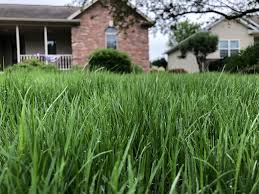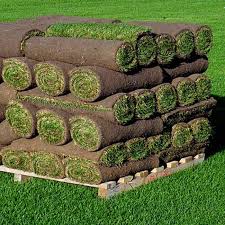Kentucky grass, scientifically known as Poa pratensis, is a versatile and popular grass species that is widely used for lawns, sports fields, and golf courses. With its lush green appearance and ability to withstand a variety of weather conditions, Kentucky grass has earned its place as one of the top choices for creating beautiful landscapes.
One of the key reasons for the popularity of Kentucky grass is its adaptability. It thrives in temperate climates and can withstand both hot summers and cold winters. This resilience makes it an excellent choice for regions with varying weather patterns, where homeowners and sports facilities seek a grass that can endure seasonal changes.
Furthermore, Kentucky grass has a dense and fine-textured growth, which adds to its aesthetic appeal. The soft, carpet-like feel underfoot makes it enjoyable for recreational activities, making it a preferred choice for sports fields and parks.
Another advantage of Kentucky grass is its low maintenance requirements. It has a moderate growth rate, reducing the frequency of mowing, and its deep root system helps it withstand drought conditions better than many other grass species. Additionally, its natural resistance to pests and diseases minimizes the need for chemical treatments, contributing to eco-friendly lawn care practices.
For homeowners looking to create an environmentally friendly landscape, Kentucky grass is an excellent option. Its deep roots help prevent soil erosion, making it beneficial for controlling runoff and maintaining healthy soil. It also has a natural ability to absorb carbon dioxide from the atmosphere, contributing to cleaner air and mitigating the effects of climate change.
However, Kentucky grass (Poa pratensis) is a versatile and attractive grass species that has earned its reputation as the go-to choice for lawns, sports fields, and golf courses. Its adaptability, low maintenance requirements, and environmental benefits make it an ideal option for creating lush green landscapes that can withstand the test of time.
Whether you’re a homeowner seeking a picturesque lawn or a sports facility manager aiming for durable playing surfaces, Kentucky grass is the green wonder that won’t disappoint
Growing and Care Guide of Kentucky Grass

Below are the Growing and Care Guide for Kentucky Grass (Poa pratensis)
1. Choosing the Right Location: Kentucky grass thrives in full sun to partial shade. When selecting a location for your lawn, make sure it receives at least 4 to 6 hours of sunlight per day. Avoid areas with heavy shade, as it may result in thinning and weak growth.
2. Soil Preparation: Prepare the soil before planting Kentucky grass. Loosen the soil to a depth of 6 to 8 inches and remove any rocks, debris, or weeds. Adding organic matter, such as compost, can improve soil structure and fertility.
3. Seeding or Sodding: Kentucky grass can be established from seed or sod. If seeding, follow the recommended seeding rate for the specific variety you’ve chosen. Sow the seeds evenly and cover lightly with soil. Keep the soil consistently moist until germination occurs.
4. Watering: Adequate watering is crucial during the establishment phase. Keep the soil consistently moist but not waterlogged. Once the grass is established, water deeply and infrequently to encourage deeper root growth.
5. Mowing: Mow Kentucky grass to a height of 2.5 to 3.5 inches. Regular mowing helps promote thick and healthy growth. Avoid cutting more than one-third of the grass blade at a time to prevent stress on the plants.
6. Fertilizing: Kentucky grass benefits from regular fertilization. Apply a balanced fertilizer in early spring and again in late summer or early fall. Follow the manufacturer’s instructions for application rates to avoid overfertilization.
7. Weed Control: Keep an eye out for weeds and address them promptly. Hand-pulling or spot-treating with appropriate herbicides can help maintain a weed-free lawn without harming the Kentucky grass.
8. Aeration: To ensure optimal root growth and water penetration, aerate the lawn once a year, preferably in the fall. This process helps alleviate soil compaction and promotes healthier turf.
9. Disease and Pest Management: Kentucky grass is relatively resistant to diseases and pests. However, keep an eye out for common issues like brown patch or white grubs. Proper lawn maintenance, such as regular mowing and watering, can help prevent these problems.
10. Winter Care: In colder regions, Kentucky grass goes dormant during the winter. Ensure the lawn is in good health before winter sets in, and avoid heavy foot traffic on frozen turf to prevent damage.
Remember that each lawn may have specific needs, so adjust your care routine accordingly. Regular monitoring, timely maintenance, and providing the right growing conditions will ensure your Kentucky grass remains lush, green, and resilient year-round.
Kentucky Bluegrass

Kentucky bluegrass (Poa pratensis) is a popular grass species cherished for its lush green appearance and resilience. This cool-season grass is well-known for creating beautiful lawns that stand up to various weather conditions, making it a top choice for homeowners and landscapers alike.
One of the key features of Kentucky bluegrass is its fine texture, which gives lawns a smooth and velvety feel. Its deep green color adds a touch of elegance to any landscape, making it a preferred choice for parks, golf courses, and residential lawns.
What sets Kentucky bluegrass apart from other grass species is its ability to withstand cold temperatures and bounce back after harsh winters. This makes it particularly suitable for regions with cold winters and moderate summers, such as the northern and central parts of the United States.
Furthermore, Kentucky bluegrass has a creeping growth habit, allowing it to form dense and compact turf. This helps to crowd out weeds and maintain an even and well-manicured lawn. Regular mowing and proper maintenance will encourage the grass to thrive and create an aesthetically pleasing outdoor space.
Another advantage of Kentucky bluegrass is its versatility. It can be grown in full sun or partial shade, making it adaptable to various environments. However, it does prefer well-drained soils and regular watering to keep it healthy and thriving.
When establishing a lawn with Kentucky bluegrass, it’s crucial to start with high-quality seeds or sod. Proper soil preparation and adequate watering during the initial growth stage will promote strong root development and ensure a healthy, robust lawn.
In addition, Kentucky bluegrass is an excellent choice for those seeking a resilient, attractive, and low-maintenance lawn option. Its lush appearance, cold tolerance, and adaptability to different conditions make it a top pick for achieving a picturesque outdoor space to be proud of. Whether you’re a homeowner or a professional landscaper, Kentucky bluegrass is sure to make your lawn the envy of the neighborhood.
Read Also: A Guide to Growing and Caring For Zenith Zoysia Grass
Kentucky 31 Tall Fescue

Kentucky 31 Tall Fescue (Festuca arundinacea) is a hardy and popular grass variety widely used for lawns, pastures, and erosion control. This cool-season grass is known for its durability and adaptability, making it an excellent choice for various landscapes.
One of the key characteristics of Kentucky 31 Tall Fescue is its ability to withstand tough environmental conditions. It is highly resistant to drought and can tolerate heat and cold better than many other grass types. This makes it particularly suitable for regions with fluctuating weather patterns and where water availability may be limited.
Moreover, Kentucky 31 Tall Fescue has a deep root system, which helps it access water and nutrients from deeper soil layers. This enhances its ability to survive periods of dryness and allows it to maintain its green color even in stressful conditions.
Another advantage of Kentucky 31 Tall Fescue is its low-maintenance nature. Once established, it requires minimal care and can thrive with infrequent watering. It also exhibits good disease resistance, reducing the need for constant monitoring and treatments.
Due to its toughness and adaptability, Kentucky 31 Tall Fescue is commonly used for erosion control on slopes and hillsides. Its dense root system helps stabilize the soil and prevent erosion, making it an eco-friendly choice for landscaping projects.
When planting Kentucky 31 Tall Fescue, it’s essential to use high-quality seeds and ensure proper soil preparation. Adequate watering during the establishment phase will promote healthy root growth and contribute to a successful lawn or pasture.
However, it’s worth noting that some homeowners may find Kentucky 31 Tall Fescue less aesthetically pleasing compared to other grass varieties. It has a coarser texture and may not provide the same lush appearance as Kentucky bluegrass, for example. Nonetheless, for those seeking a hardy and low-maintenance grass option, it remains an excellent choice.
In addition, Kentucky 31 Tall Fescue is a reliable and resilient grass variety suitable for a wide range of applications. Its ability to endure harsh conditions, low-maintenance requirements, and erosion control capabilities make it a practical and budget-friendly option for creating functional and sustainable landscapes. Whether you’re landscaping a large property or looking for an eco-friendly lawn option, Kentucky 31 Tall Fescue is worth considering.
Read Also: A Guide to Growing and Caring For Zoysia Grass (Zoysia Spp)
Kentucky Bluegrass Grass Sod

Kentucky bluegrass grass sod is a popular choice for those seeking an immediate and lush lawn without the wait for traditional seed germination. Sod is essentially mature grass, together with its root system, grown and harvested by turf farms. When laid on prepared soil, it quickly transforms bare ground into a beautiful green lawn.
One of the main advantages of using Kentucky bluegrass sod is its instant effect. As soon as the sod is installed, it provides an established lawn, saving you the time and patience required for seed germination and growth. This is particularly beneficial for those who want a quick transformation for their outdoor spaces, such as homeowners preparing for events or new construction projects.
Furthermore, Kentucky bluegrass sod is known for its fine texture and rich green color, giving your lawn a well-manicured and elegant appearance. Its soft feel underfoot adds to the overall enjoyment of the outdoor space, making it a great choice for areas where you and your family spend leisure time.
Sod installation requires careful preparation of the soil to ensure proper root establishment and successful growth. The area should be cleared of debris, leveled, and lightly compacted before laying the sod. Adequate watering during the first few weeks is essential to help the roots establish in the new soil.
Once the Kentucky bluegrass sod is fully established, it will exhibit the same characteristics as traditionally seeded Kentucky bluegrass lawns. It’s a cool-season grass that thrives in regions with mild summers and cold winters, making it ideal for northern and central parts of the United States.
While sodding can be more expensive than seeding, the benefits of instant lawn establishment and the ability to enjoy a beautiful lawn sooner often outweigh the cost for many homeowners.
In conclusion, Kentucky bluegrass grass sod offers a convenient and efficient way to create a lush and attractive lawn without the waiting time required for traditional seeding. Its immediate impact, fine texture, and enduring green color make it a popular choice for achieving a picturesque outdoor space.
Whether you’re preparing for a special occasion or simply looking to enhance your property, Kentucky bluegrass grass sod can be the perfect solution for your lawn needs.
Read Also: How To Make A Gum Wrapper Chain
